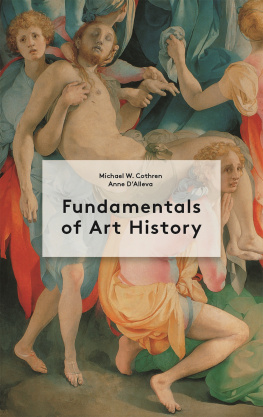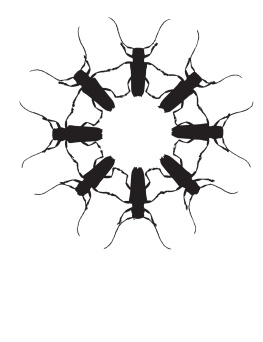Contents
Guide
Fundamentals
of Art History

Published in Great Britain by
Laurence King Student & Professional
An imprint of Quercus Editions Ltd
Carmelite House
50 Victoria Embankment
London EC4Y 0DZ
An Hachette UK company
Originally published in the US as Look! The Fundamentals of Art History,
1st ed. 2004, 2nd ed. 2006, 3rd ed. 2010, and in the UK as
How to Write Art History, 1st ed. 2006, 2nd ed. 2010.
Design 2021 Laurence King Publishing Ltd
Copyright 2010, 2006, 2004 Anne DAlleva
This revised edition Text 2021 Michael W. Cothren, Anne DAlleva
All rights reserved. No part of this publication may be reproduced or transmitted in any form or by any means, electronic or mechanical, including photocopy, recording or any information storage and retrieval system, without permission in writing from the publisher.
The moral right of Michael W. Cothren and Anne DAlleva to be identified as the authors of this work has been asserted in accordance with the Copyright, Designs and Patents Act, 1988.
All rights reserved. No part of this publication may be reproduced or transmitted in any form or by any means, electronic or mechanical, including photocopy, recording, or any information storage and retrieval system, without permission in writing from the publisher.
A CIP catalogue record for this book is available from the British Library
TPB ISBN 978-1-91394-701-9
E-BOOK ISBN 978-1-52942-319-8
Quercus Editions Ltd hereby exclude all liability to the extent permitted by law for any errors or omissions in this book and for any loss, damage or expense (whether direct or indirect) suffered by a third party relying on any information contained in this book.
Commissioning editor: Kara Hattersley-Smith
Development/editor: Liz Faber
Design: The Urban Ant
Picture research: Peter Kent
Michael W. Cothren
Anne DAlleva
Fundamentals
of Art History
Laurence King Publishing
An imprint of Quercus Editions Ltd
www.laurenceking.com/student/
Contents
Introduction
How to use this book
Chapter 1
Making art history
Chapter 2
Style and subject
Chapter 3
Contextual analysis
Chapter 4
Surviving and succeeding: art-history examinations
Chapter 5
Writing art-history papers
Conclusion
The rewards of studying art history
Appendix
A brief history of art history
Acknowledgments
Anne DAlleva
This book has been both a long and a short time in the making. Much of the insight presented in the original edition I learnedthe hard wayas an undergraduate and postgraduate student of art history. Fine colleagues at Columbia University, the University of St. Thomas, and the University of Connecticut have contributed to my growth as a teacher and communicator. In particular, I would like to acknowledge conversations with John Farmer, Amanda Badgett, and Diana Linden for the inspiration they have offered me. And Kelly Dennis wisely suggested that I address the controversies that art can generate. I should also like to thank the reviewers for their very helpful assessment of how the book could be improved: John A. Seed, Mount San Jacinto College; Sarah Elizabeth Moyer, The University of Utah; Stephanie L. Taylor, New Mexico State University; Roann Barris, Radford University; and Anne Betty Weinshenker, Montclair State University.
A number of people have helped with this book. First, I should acknowledge the steady stream of students who have asked questions: demanding that I explain things more clearly and give them better tools for learning. My thanks are also due to those who permitted me to quote from their papers. The book benefited greatly from the trenchant critiques it received from Meghan Dahn and Alexis Begin. And along with Philip Buntin, Meghan also helped compile the endmatter, as did Michael Young, the University of Connecticuts art librarian. My agent, Gary Morris, has been an essential supporter of this project and I am grateful for his help. The terrific professionals at Laurence King Publishing deserve a great deal of recognition for their hard work on this book: Kara Hattersley-Smith, Donald Dinwiddie, Peter Kent, and Andy Prince. I owe a special debt of gratitude to Michael Bird for carrying out the revisions and editing the second edition.
Finally, I must thank my familyparents, sisters, and nephewfor their encouragement. My partner Cathy Bochain has shown unswerving support for me and my work, even under the most difficult circumstances. Both she and our son, James, make life a joy.
Michael Cothren
I am deeply grateful to Kara Hattersley-Smith for offering me the opportunity to revise Anne DAllevas How to Write Art History (as this book was previously known) for its third edition. She and her colleagues Liz Faber and Peter Kent at Laurence King Publishing offered wise counsel, warm support, and patient encouragement throughout the project. Thanks also to copy-editor Jessica McCarthy, designer Vanessa Green, and production controller Simon Walsh. I will always be grateful to Sarah Touborg and Helen Ronan, who first helped me learn to teach art history in writing to students far beyond my classrooms at Swarthmore College. I am indebted to many cherished and dedicated colleagues at Swarthmore, as well as generations of bright, challenging, and deeply curious students. What I know about teaching I learned from four decades of working with them.
Many people offered information and support. Here I can single out only a few. Kirsten Ringelberg suggested updates for the bibliographies. My dear friend Stephen Lehmann graciously agreed to provide the human scale in . My cherished colleague and friend Elizabeth A.R. Brown recommended the extraordinary beauty of Scott Rosss recordings of Couperin, and listening to them while I wrote both nourished me and helped me focus on this work.
Three extraordinary teachers introduced me to the three works of art used as case studies in . During an undergraduate semester abroad in Aix-en-Provence in 1971, artist Franoise Jourdan Celly initiated my path toward art history by dispatching me to Padua to spend a day drawing from Giottos frescos. In 1975, as an art-history graduate student at Columbia University, I enrolled in a seminar with Marie Lukens Swietochowski (19282011) which met in the intimate setting of a storeroom at the Metropolitan Museum of Art. Her keen eye, supremely sensitive to the stylistic subtleties of Safavid narrative painting, led us through an examination of the Shahnama of Shah Tahmasp while we held the individual leaves of this astonishing book in our hands. More recently, Steven LeBlanc introduced me to the startling sophistication of the paintings within Mimbres bowls, inviting me to join his project of sorting them, on the basis of style, into the work of identifiable artists. Art history is about human relationships as well as artifacts, and my own life in art history was enriched by my relationships with these three mentors.
My work on this book began in spring of 2019, as I was partnering with my wife, Susan Lowry, in Santa Monica, California, to provide childcare for our sweet angel of a granddaughter, Layla Cothren Small. I completed the revision in summer of 2020, while Susan and I sheltered at home in Sedona, Arizona, securing ourselves from, and helping prevent the spread of, the devastating pandemic of COVID-19. I mention Susan and Layla here because I cannot imagine doing this work without the joy and promise that Layla brought into our world at her arrival in 2018, and the love and support that Susan has given me over a lifetime in art history. My work on this third edition is dedicated to them.











